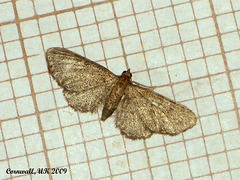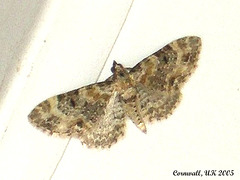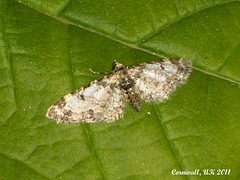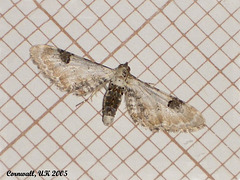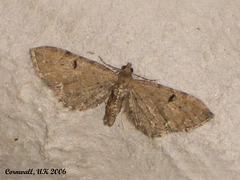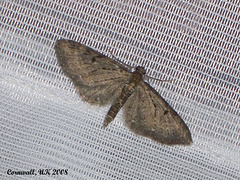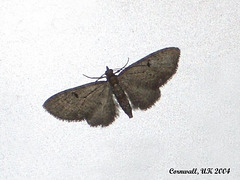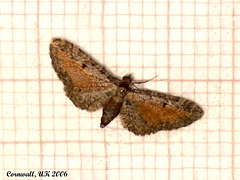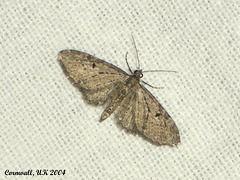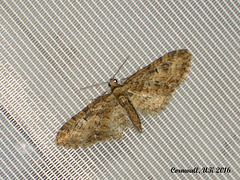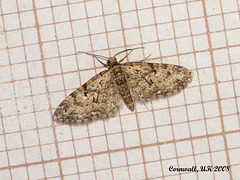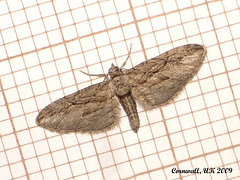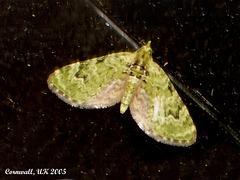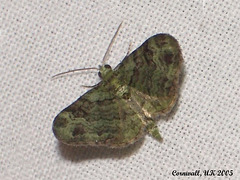
Cornwall Moths: Geometridae
Folder: Moths in Cornwall UK
A big update to Cornwall Geometridae, with a lot more species now illustrated. A few more have yet to be photographed for a reasonable reference picture, so hopefully they will be added through 2016. However, it will depend on whether we can record them in the right places at the right time of the year. Only time will tell.
This album lists the different species I've recorded over the years in th…
(read more)
1809 Perizoma d. didymata (Twin-spot Carpet)
| |
|
Geometridae, Larentiinae - Wingspan: 22-30mm.
Although this species is considered common throughout the UK, it is not recorded often in Cornwall, usually occurring as single specimens found scattered through the county.
The UK flight season ranges from June to August, although there has been earlier records in May in Cornwall. The most records here occurs in July.
1814 Eupithecia plumbeolata (Lead-coloured Pug)
| |
|
Geometridae, Larentiinae - Wingspan: 18-20mm.
A Nationally Scarce species registered on the Nb-list.
1817 Eupithecia pulchellata (Foxglove Pug)
| |
|
Geometridae, Larentiinae - Wingspan: 20-24mm.
A common species throughout the UK, and widespread in Cornwall. An easy species to identify as the grey cross band has a sharp bend in the outer edge near the leading edge, whereas the similar Toadflax Pug has a smoothly curved edge.
The flight season in Cornwall ranges from April to August, with occasional individuals being seen in September. The wide peak in the population reaches a maximum in June.
1818 Eupithecia irriguata (Marbled Pug)
| |
|
Geometridae, Larentiinae - Wingspan: 18-22mm.
A Nationally Scarce species on the Nb-list occurring in southern counties only. As far as we know, it only occurs towards the east of Cornwall. The wing pattern of this species is quite distinct, so it is easy to recognise if you are lucky enough to come across one.
With only a few specimens recorded, it is difficult to specify a flight season, but the only occurrences I know of were in April, at a specific location.
1819 Eupithecia exiguata (Mottled Pug)
| |
|
Geometridae, Larentiinae - Wingspan: 22-24mm.
A common species ranging throughout the UK, but more likely to be seen in the south. It is widespread through Cornwall. A similar species is the 1860 Green Pug, particularly when the latter is faded. However, the wing-tip spots on this species are reflected on the underside, whereas it isn't on the Green Pug. Even when faded, there is usually a faint green colouration in the wing roots of that species.
The flight season for this species occurs between April and July, peaking in May / June. Occasional individuals may be seen in March and August, depending on weather conditions.
1823 Eupithecia venosata (Netted Pug)
| |
|
Geometridae, Larentiinae - Wingspan: 20-28mm.
A locally distributed species through the UK. There are a number of sub-species forms known, but the basic species shown above is more generally distributed. This is the form seen in Cornwall, but they are not observed very often tending to be observed around coastal areas, where various species of Campion (Silene spp.), the larval food plants grow.
There is a narrow flight season annually, in May /June, with an occasional early individual in April. There are not enough records available for Cornwall to determine a peak, the flying season itself representing it.
1825 Eupithecia centaureata (Lime Speck Pug)
| |
|
Geometridae, Larentiinae - Wingspan: 20-24mm.
A common distinctive species throughout the UK with no problems for identification. It is widespread in Cornwall.
The flight season occurs from May to September, and is made up from two overlapping generations, numbers peaking in July / August. Occasional specimens may be seen in late April.
1832 Eupithecia assimilata (Currant Pug)
| |
|
Geometridae, Larentiinae - Wingspan: 18-24mm.
A common species throughout the UK. In Cornwall they seem to be a bit more common in the east of the county than the west, but numbers are not as prolific as some common species. Very similar to the Wormwood Pug, but some features serve to separate them, when they are a little faded. The central fore-wing spot is very prominent and elongated in the Currant Pug. Where the white spots near the rear outer edge, and the leading edge dark spots are faded, this species also has specific body patterns, where the front abdominal segments make a light inverted triangular shape, and the rest of the abdomen has a dorsal white line. Although the Wormwood Pug has a broad white band, it is not triangular, and neither is there's white dorsal line on the abdomen.
The flight season for this species ranges from May to August in two overlaid generations, but occasional specimens may be seen in April or September.
1835 Eupithecia tripunctaria (White-spotted Pug)
| |
|
Geometridae, Larentiinae - Wingspan: 20-24mm.
A locally occurring species more likely to be found towards the south of the UK. It is generally distributed throughout Cornwall in suitable sites. Named from the light spots at various parts of its body and around the edge of front and back wings, but in worn species, some may not be visible. The body has a single light spot at the back of the Thorax, and when visible, there are two small spots on each side of the abdomen.
The flight season of this species is from May to August, with occasional individuals being recorded in April and September in Corrnwall. There is a very small spread peak in May / June, followed by a second bigger generation in August.
1835 Eupithecia tripunctaria fm angelicata (White-…
| |
|
Geometridae, Larentiinae - Wingspan: 20-24mm.
This is an almost uniform black version of the species which is a widespread melanic form, which normally occurs near industrial areas. However some of the vestigial spots can be seen on the wings, as well as the body in the usual places. In this form they are not white, but dark grey, being only just a little lighter than the background.
1837 Eupithecia subfuscata (Grey Pug)
| |
|
Geometridae, Larentiinae - Wingspan: 20-24mm.
A common species throughout the UK, and also in Cornwall. It is recognisable by the three double bands across the fore-wing, the middle pair of which loops around the prominent discal spot. Additionally, the abdomen has a pale dorsal stripe, which has black dots spaced along it.
A species common throughout the UK, and also Cornwall, occurring in almost all types of habitats. The larvae are quite omnivorous, feeding on a wide variety of food-plants. Primarily considered in the UK to have a flight season May & June, but in Cornwall it is possible to see individuals as early as March or April, and commonly as late as August, possibly due the a second generation.
1838 Eupithecia icterata (Tawny-speckled Pug)
| |
|
Geometridae, Larentiinae - Wingspan: 22-26mm.
An unmistakable species widely distributed throughout the UK, but more sparsely through Cornwall. The common colouring is shown above, but further north in the UK the orange area is much reduced and almost absent. It occurs in a wide range of habitats, but mainly in open areas.
The adults are most likely to be seen in July / August with occasional individuals in Cornwall appearing as early as May, and as late as September.
1851 Eupithecia virgaureata (Golden-rod Pug)
| |
|
Geometridae, Larentiinae - Wingspan: 20-22mm.
A local species most likely to be found in the west of the UK, and more in the west of Cornwall. A smaller species than the similar Grey Pug, but it the discal spots are larger and more rounded than that species. Additionally many of the wing veins are accentuated with black dashes, and the rear of the thorax has a usually distinct lighter patch there.
The flight season in the UK is composed of two generations in the south, typically May / June, and August. In Cornwall, individuals can also be found occasionally in April, and the generations tend to overlap more making a broad season.
1852 Eupithecia abbreviata (Brindled Pug)
| |
|
Geometridae, Larentiinae - Wingspan: 20-24mm.
A common generally mottled-brown Spring species which is one of the first of this group to herald the new season. Features to identify this species are a thin elongated central black spot, and a small row of black often-triangular marks just outside it against the light outer band across the fore-wing. The thorax has two darker chevrons at front and back of the segment, and sometimes a small black dot in the centre. The front of the abdomen has a paler band the rear thoracic chevron, and is edged on the rear of it by another dark band.
There is a broad single generation peak between March and May, although in Cornwall, individuals can also be seen in February and June. Normally abundant, a number will come into a light trap most days in its season.
1853 Eupithecia dodoneata (Oak-tree Pug)
| |
|
Geometridae, Larentiinae - Wingspan: 16-22mm.
A common species in central and southern areas of the UK, and throughout Cornwall, this smaller Pug can be easily confused with the Brindled Pug, particularly when a bit faded. Generally, the wing patterns are more contrasting, with a paler background and darker markings. Although the black triangular spots along the outer band are present, these are usually much smaller, and accentuated at the lower part of the fore-wing with black dashes along the veins. Although sometimes difficult to discern, the abdomen tends to be a more orange colour, as sometimes are the fore-wing front and rear edges.
The flight season in the UK is April to early June, although in Cornwall, individuals may be found occasionally in March and July.
1855 Eupithecia phoeniceata (Cypress Pug)
| |
|
Geometridae, Larentiinae - Wingspan: 20-22mm.
An uncommon species which appears to have established itself since the first discovery in Cornwall in 1959. It has now spread along the south coast to Kent, whilst occurring in English counties north to the south of Wales. A uniquely patterned species, which is unmistakable, and the ground colour is a light brownish-grey. It's larvae feed on garden fir hedging, so has the opportunity to benefit from our gardening activities.
In Cornwall, the flight season is August to early October with occasional individuals being recorded in May and July. The larvae overwinter, feeding in mild weather, and pupate in March / April.
1858 Chloroclystis v-ata (V-Pug)
| |
|
Geometridae, Larentiinae - Wingspan: 16-22mm.
A common species throughout the UK, and widespread in Cornwall, this species is a distinctive green colour with a prominent black "V" in the fore-wing centre. If that is not enough to identify it, it usually rests, unlike any other Pug, with its wings swept back forming a pronounced Inverted "V"-shape, covering the grey hind-wings completely.
The flight season in the UK is made up from two generations in the south, from May / June, and July / August. However, in Cornwall it is seen almost throughout the year with records occurring from February to November. The two generations appear to overlap here, and may even include a third in favourable years.
1860 Pasiphila rectangulata (Green Pug)
| |
|
Geometridae, Larentiinae - Wingspan: 16-22mm.
A common species throughout the UK, and widespread in Cornwall. When freshly emerged, the only other Pug similarly coloured is the V-Pug, but that species distinctive "V" Mark and the rest posture serves well to differentiate them. Faded Green Pugs, tend to lose their green colouration on the wings, although it may stay around the body area. With a superficial similarity with blotches near the tips of the fore-wings, when grey, it can sometimes be confused with a Mottled Pug, although with that species the blotches are reflected on the underside of the wings. That species is a little earlier than the Green Pug, but can still overlap.
The flight season in the UK is defined as June to Early July, although in keeping with many other species, it is extended in Cornwall with individuals recorded from April to August.
Jump to top
RSS feed- Latest items - Subscribe to the latest items added to this album
- ipernity © 2007-2024
- Help & Contact
|
Club news
|
About ipernity
|
History |
ipernity Club & Prices |
Guide of good conduct
Donate | Group guidelines | Privacy policy | Terms of use | Statutes | In memoria -
Facebook
Twitter


